Biographical Notes
Berlin March 20, 1998
Revised Boulogne sur Mer August, 5th, 2025
LUSICI
*25.02.1942 - 12.03.2024
"The Time Is Right For Lusici!
Everybody has to have a number !"
by D.Bohne
(German language version) Whoever
has experienced former East German artist Lusici "live"
in his wonderful West Berlin Studio, close to the night life
centre of Kurfürstendamm - will agree: art is alive and
amongst us. Art is no artful thing for some elite.
Lusici was born Dietrich Schade in former the East German
territory of Lausitz / Spreewald, in Ragow, to be exact. He was
born in the middle of the chaos of the WWII, in 1942.
Long and extended walks in the nearby Spreewald made him realise
the richness of mother nature. This made him sensitive and an
observer of the colours of nature. His curious nature taught
him to mix colours and translate his observations into paintings.
(right: "Die Kahnfahrt" - The canoe ride in Spreewald
- 1956, oil on paper, 39 x 33 cm, private collection).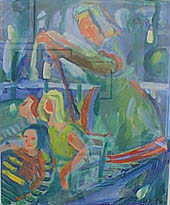
Later he learned how to provoke reactions, even irritate by
using colours. His natural experience were brought to paper as
portraits ("Baumportraits") or Girls from the Lausitz
("Lausitzer Mädchen").
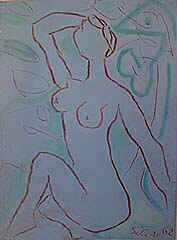 Left:
"Girls From The Lausitz - sitting, turned to the left",
("Lausitzer Mädchen: sitzend nach Links"), 1962,
pigments with glue and latex on paper, 49 x 37 cm Left:
"Girls From The Lausitz - sitting, turned to the left",
("Lausitzer Mädchen: sitzend nach Links"), 1962,
pigments with glue and latex on paper, 49 x 37 cm
Already by 1957 the first self portrait appears. It shows
the artist in front of his easel. On it he is about to finish
one of his later famous and award winning angels. From the back
a strange figure puts his hand over his shoulder: the personalised
death. Part friend, part stranger.
This early work originated already at the age of 15, in 1957
(water colour on paper, 29,5 x 21, in private collection). It
is an early sign for his resistance to the public authorities
of the GDR, and his feeling of being drawn between his need to
create harmony and instigation at the same time.
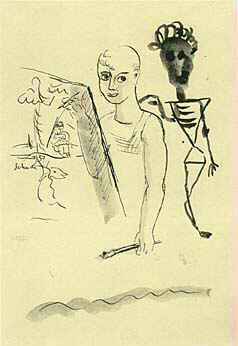
Lusici draws intensively in the experience of life, the relationship
between nature and the human being, while he digs in the basic
values of the human nature.
From 1961 the Berlin Wall leaves an immense impact on all
the work that follows. By then Lusici still lives in the Lausitz.
Aged 26 he moves to East-Berlin in 1968, where he remains through
all the troubled years until 1986.
He finishes the master class (MA) in the famous Berlin Academy
of Art (Akademie der Künste Berlin) of East Berlin. There
he "learned the basics of painting", only, he says.
The artist Dietrich Schade becomes Lusici. The Italian flair
of the chosen alias was a piece of rebellion in the restricted
post war years of East Germany. It is also the historic translation
of Lausitz.
Lusici wins the gold medal in the Unesco competition of 1974
for his interpretation of a given theme: "Water is Life!"
(Wasser ist Leben). This was printed as a poster (on the right);
on the left side Lusici's original concept sketch.
 "Wasser ist Leben", last
version of a study. 1973 "Wasser ist Leben", last
version of a study. 1973
Oil on paper, 47 x 26 cm, artist's archive |
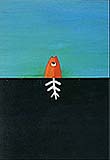 "Wasser
ist Leben", 1974, Poster "Wasser
ist Leben", 1974, Poster |
|
In all his paintings he had developed a language of protest
in order to surpass the East German authorities. Lusici achieved
what not many artists could: an unnoticed exit from the system
through art: "….My "Art" helped me to survive
the East German communist regime."
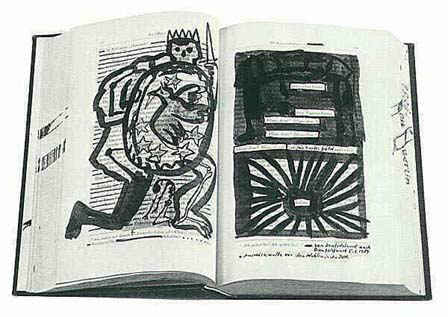
so called "Malerbuch: Ausgelebte Schriften",
1984; (übermaltes Marxismusbuch, ca. 800 Seiten ), Museum
f. Preussischer Kulturbesitz Berlin, Kupferstichkabinett |
He starts what he so called "Painting
Books" (Malbücher), under the title "Dead texts"
(Ausgelebte Schriften), which in fact were intervened Marxism
theory books, which he painted over. (800 pages in 1984), in
posession of the National Museum, Preussischer Kulturbesitz Berlin
(Kupferstichkabinet).
At the time Lusici keeps as well an exact diary, in which
he does many sketches. "If I were not able to breath anymore,
I started to paint over another Marxism book!". As sign
of protest he paints over almost anything that carries symbols
of the public East German authorities. Amongst them are prohibition
road signs and the GDR flag. 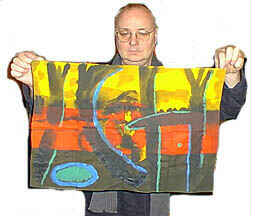 This act of protest could have brought him in the
national high security prison but the piece of cotton slipped
between some pages of a book and was found after the reunification.
(see photo: "The big ego"/"Das grosse Ich",
1962, registered opus 62B17, in possesion of the artist). This act of protest could have brought him in the
national high security prison but the piece of cotton slipped
between some pages of a book and was found after the reunification.
(see photo: "The big ego"/"Das grosse Ich",
1962, registered opus 62B17, in possesion of the artist).
Under communist rule Lusici lacked, as everybody else in the
GDR, the basic materials. But Lusici always found ways to continue
painting. He used wood, unused posters from street advertising,
or even just corners of posters - whatever he could put his hand
on.
Already at the age of 23, in 1965, he started using numbers which
appeared on the canvas like reflected in a mirror. The number
"4" acquires an important role on his life. The four
becomes more than just a number, it stands for separation, the
East-West conflict. "Mirrored numbers are erotic and aggressive";
he tells me. Lusici creates the phrase of "Anti-Numbers"
("Antizahlen"), describing paintings like train wagons
taking people into the ghetto.
The number "8" stands for balance. It creates harmony,
while numbers like "1", "2" or "3"
bring certain erotic balance. The "5" is the king and
therefore sometimes has a crown, if seen "straight"
in a particular painting.
The Lusici phrase "3+5=0 "is significant on its
own absurdity. Everybody needs a painting with numbers in his
house to remind him how numbers determine our senses and feelings.
"We have organised ourselves in this way. We are counting
us poor, because, if we carry on counting in this way we always
count to wrong results!" For Lusici we all live in a dictatorship
of numbers.
Lusici always observed many artists' progress in the west.
"They are trying always to find a style first". Lusici
tried to find himself first.
Lusici survived 25 years of East German government and moved
to the West in 1986. Friends supported him in this move, which
was accompanied by many difficulties due to the East German police
and border control. He managed to leave amongst the first, leaving
the country "in a very adventurous way", this is all
he wants to tell us about it.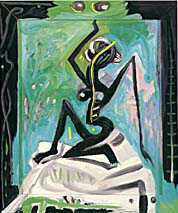
"The Arrival"/"Ankunft" (right), 1986,
oil on wood , 76 x 63,5 cm, in Privatbesitz) is his first ever
Western oil painting.
With his family in the arm and little hand luggage he arrives
in the West-Berlin camp for immigrating East Germans in Marienfelde.
Here there was also danger waiting for him. The promised west
didn't look in reality as in American TV series, which slipped
through the GDR censor.
"Even capitalism has its limitations", he says.
"And Marx was surprisingly right, saying that a day of work
is a lost day in the life of the worker", he continues and
reflects on society: "any social system is doomed to fail
after it has grown to a state of perfection. Lies are the beginning
of censorship and restriction, the opposite of freedom",
quoting a Chinese proverb.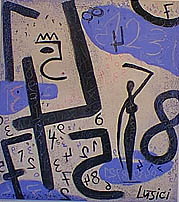
"This is - why the time is right" for Lusici, he
adds with a twinkle in his eyes. His art work seems more than
ever up-to-date. Lusici's art is still protesting, proclaiming
and speaking out.
("The Queen is sitting in the Opera House, the King counts
the money in the tresury" - "Die Königin sitzt
in der Oper - der König in der Schatzkammer und zählt
Geld", 1995, Acryl on canvas, 140 x 120cm)
3+5=0 "
Lusici describes his own art as "road signs". His
so called "million dollar baby", or the piece he suggest
to sell only for a million, is a portrait of his favourite painter
of all times, Vincent van Gogh. It was made in 1987, when Gogh's
"Schwerlilien" was sold at an auction for one million
dollars.
His protest carries double meaning: The front is a homage to
van Gogh, gold plated; while the flip side carries Lusici's hand
written note saying: "The idiotic price for a piece of art….!
This is a black day for the art, but a lucky day for van Gogh.
The idiotic price of 81 million dollar this painting was auctioned
for, spoils everything." And with sarcasm he adds: "Who
wants to buy this master piece of mine, should at least put a
million on the table….!"
"Hommage on Vincent van Gogh (Schwertlilien) - Der Irrenpreis",
1987
oil and bronze on canvas, 140x120cm (Details page 30)
Recent Exhibitions:
- Since 1992 permanent exhibition and room decoration in the
Kempinski Plaza Hotels Berlin.
- Deutsches Porzellan-Museum, Hohenberg-Egger bei Selb/Oberfranken,
Dezember 1997 bis März 1998
- Kunstforum im Klinikum Großhadern (München) 10.12.1997
bis Ende März 1998
- Artwork by Lusici can be found in the following collections:
Berlin, Berlinische Galerie, Berlin, Staatliche Museen Preussischer
Kulturbesitz, Kupferstichkabinett, Bremen, Kunsthalle, Dresden,
Staatliche Kunstsammlung, Kupferstich-Kabinett, Ein Hod (Israel),
Janco-Dada-Museum, München, Bayerische Staaatsabibliothek,
Handschriftenabteilung, Paris, Musée des Arts Décoratifs,
Stendal, Winckelmann Museum, Stuttgart, Staatsgalerie, Warschau,
Nationalmuseum, Artbust.

http://www.Lusici.com |